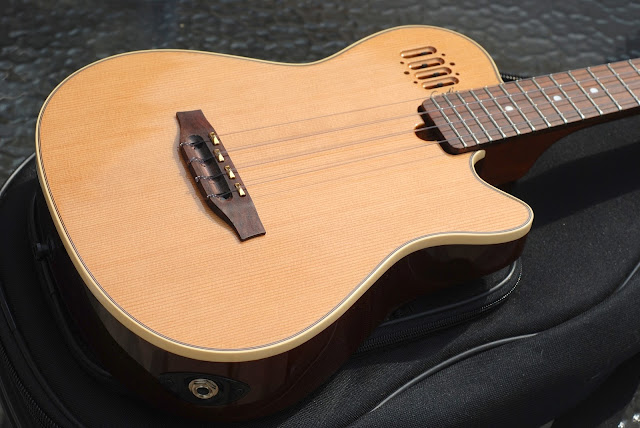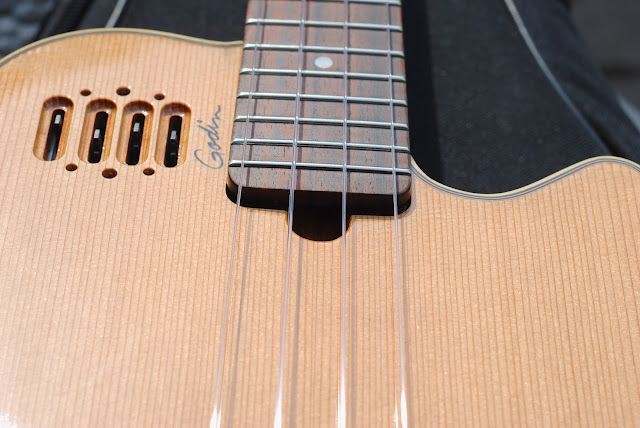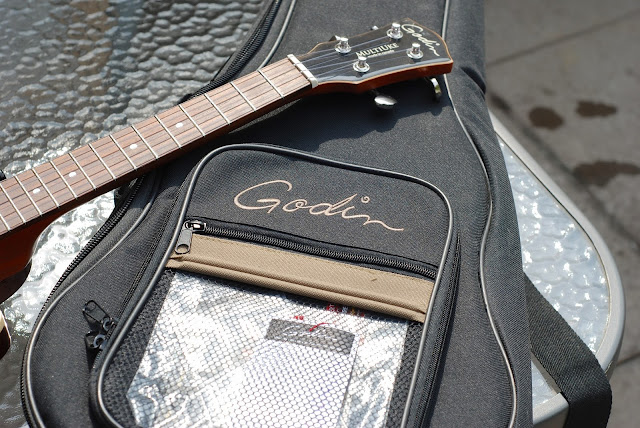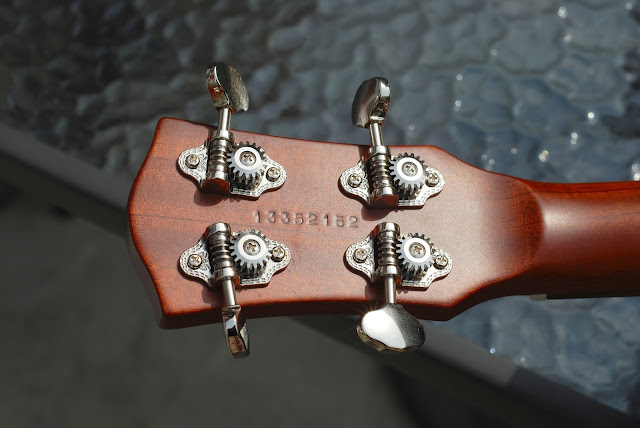Time for a ukulele that is a little out of the ordinary, and perhaps a uke that will divide opinion. Say hello to the Godin MultiUke.
 |
The MultiUke takes that Multiac technology (and looks) and applies it to a quite unique tenor instrument. In short summary it is primarily an electric ukulele, but built around a semi hollow chambered body to give resonance without feedback (there is no sound hole!). The devil is in the detail with the MultiUke and Godin say they designed this, and the pickups from the ground up in order to give superior sound and playability. With an RRP of $850, this is no cheap ukulele, but more on where that money has gone below.
So we have a regular (ish) tenor scale ukulele (17" scale). The main body is made of chambered mahogany, actually made of two pieces joined down the middle, and topped with either a solid cedar top (as in this case) or an alternative sunburst spruce top. As pretty as the sunburst looks I opted for the understated looks of solid cedar. The chambering inside the body of the instrument is otherwise hidden but serves a couple of purposes. First it is mainly chambered around the lower bout of the uke and under the bridge to give resonance and to allow that top to move. This is essential for sustain and tone. The chambers also house the various wiring, pickups and batteries that drive the thing.
So first, let's take a look at that top. It really is a rather pretty piece of wood. There is no curl in this (being cedar I suppose) so we have nice straight bold grain lines that run perfectly from tail to neck. It is made of two pieces of solid cedar joined down the middle. And there is a LOT of cedar to look at. Whilst this is a tenor scale, the uke is wider than most tenors I have played, particularly around the butt. As I say above, there is no sound hole on the MultiUke - a plus point for live performance, as no feedback from the sound hole, but meaning more cedar on show. The only holes on the top are the entry point for the neck truss rod bolt and the channels for the sound control sliders next to a Godin name label. More on those further on. The finish of the top is a high gloss, and whilst I am not normally one for gloss, this is beautiful and will protect what is otherwise quite as soft wood. It's simple looking, yet on a far from traditional design. In that sense I suppose it doesn't need any bling!
 |
| Cedar top |
The top is joined to the chambered body with cream edge binding with a black trim. It is applied very nicely and quite deep and I think provides a nice contrast with the much darker coloured back. Overall I love the shape of the top, which is vaguely Telecaster ish, using a slightly squarer top horn to house the controls, and a cutaway for high fret access on the bottom horn.
I won't talk about the sides separately from the back as they are part of the same construction. The back is a chunky affair, finished in a beautiful deep red gloss that really shows of the mahogany grain beneath. The back is also shaped and tapered rather like a Stratocaster with a slight curve inwards on the top edge of the back, and also on the horn making for a more comfortable playing experience when you have this thing strapped to your body. I think it looks wonderful. Elsewhere on the back we have the access port for servicing the pickup controls, and a compartment for a 9v battery. Strap buttons are provided made of blackened metal on the butt and on the top horn adjacent to the end of the neck. The jack socket is not square on the base but offset like you will find on many electric guitars and is mounted on a black metal surround.
 |
| That gorgeous contoured back |
The whole body feels very solid and makes it come across as a serious instrument. It's rather like the first time you pick up a Gibson Les Paul... That construction also shows in the weight - this is a heavy ukulele and certainly heavier than any traditional electro acoustic you will find. That is not to say it is overly heavy but serves as another element that may divide opinion. If you play this uke standing up you WILL want a strap.
 |
| bottom strap button and jack socket |
On to the neck, and the first thing you notice is that it is bolted with three screws to the body, making it one of the first ukes I have seen to employ that design. I suspect the reason is down to the construction of the chambered body meaning it would have been too much of a job to create a set neck in a pocket. The debate always rages in the electric guitar world as to whether set necks or bolt on necks are better, but I have never been convinced either way. At the end of the day, it works for the Stratocaster, the worlds best selling electric guitar, but I appreciate this too may put off ukulele purists. Another point on that though. The bolt on design means that the uke action can also be tweaked over time by re setting the neck with a shim to raise or lower it away from the strings. I suspect you will never need it but the option is there if you are that way inclined. In addition, if you snapped the neck, fitting a replacement would be a five minute job!
The neck is made of mahogany and I was pleased to see it is finished in satin and not gloss like the rest of the uke. A gloss finish neck can, I find, feel quite sticky on the hands. This is silky smooth and very nicely finished. The neck is made of three pieces with a joint at the heel, and one at the very end of the headstock. This is a slight disappointment on account of the price, but will in no way affect the sound (nor is it noticeable). I really do like the whole design and shaping of the neck joint, but I am geeky like that.
 |
| Neck joint and bolts |
The neck is topped with rosewood and comes with 19 fairly chunky nickel silver frets. The rosewood grain is dark and straight with no pale patches or stripes. Fret markers are in mother of pearl at the 5th, 7th, 10th, 12th and 15th and these are, thankfully, repeated on the side. The edge of the fretboard is unbound which I found surprising, meaning the edges are visible. I think a cream edge binding would have really set the ukulele off and matched the body. That said, the whole neck and the frets are finished beautifully with not a rough edge in sight. The fret board is also radiused which is usually something reserved for the highest end ukes. That means the frets are not set completely flat, but the fingerboard has a very slight curve to it (a 24" radius in fact). This adds to playability as it provides the fingers with a more natural landing position. And yet another plus, the edges of the fretboard are rolled and curved - another high end uke trait, meaning no hard edges and a silky smooth feel.
And.... we have a truss rod! This is a threaded bolt of metal that runs through the length of the neck and is adjustable to create a slight bow in the neck. This is common on guitars, and an essential tool for adjusting action (to some degree) but more importantly playability. It allows a small amount of concave relief to be put into the fingerboard making playing easier, and reducing buzzes. Rarely seen on a uke (with the exception of Pono) it's a nice addition. Access to the truss rod is via a small opening on the top, and Godin even supply you with an allen key to adjust the hex bolt.
 |
| Truss rod opening |
Up to the headstock, we first pass the nut which is made of Tusq Nubone. I adore the shape of the headstock and the finish of the facing plate which is in a kind or raised glossy black wood finish. It really does give the instrument a high end feel and look. The Godin logo is emblazoned across the top, with the words MultiUke and MADE IN CANADA in a different orientation which jarred on me a little I must say. I don't think either are really necessary, so why not stick with just 'Godin'?
 |
| Headstock |
Flipping the headstock over we have unbranded but very pretty open geared tuners, with classy shaped silver buttons. The instrument serial number is also embossed in the back of the headstock wood.
Yet, so far we haven't actually looked at what makes this ukulele rather different. The pickup system. Godin have utilised a custom voiced RMC brand system on the MultiUke. They say it was developed specifically for this instrument, but underneath its basically the technology they use on their Multiac guitars. This is a seriously high quality pickup and goes some way to explaining why this instrument has the price tag it has. You will spend the best part of $200 to get an RMC acoustic pickup system on it's own, so this is no cheap $50 piezo strip.
A quick word on that. Readers of this site will know that I normally prefer passive systems to those with on board electronics. Generally it means the uke will sound more natural. This is not a passive system, it's a powered one and therefore may seem to go against what I prefer. All I will say is, read on, and bear in mind that this is a professional pickup system, not a cheap Belcat that get's fitted to a $150 ukulele.
The RMC pickup differs from most other systems you will have seen in that it provides an individual pickup to each string. That's right, four pickups! There is no normal saddle on this instrument as you will see, rather each string sits on it's own pickup saddle that have been placed into the rosewood bridge. They look great and are finished in gold, like four little shiny pyramids. On the top of each is a groove to keep the string in place.
Controls for the system are provided on the top left of the top of the uke, by way of four sliders. These control volume, treble, middle and bass providing a lot of sound shaping options. Again, more on that later. The whole thing is powered by a 9v battery in the back of the uke and outputted via a standard 1/4 inch jack socket.
 |
| Pickup controls |
A couple of things to note about those pickup saddles. They are set in one place and one place only, admittedly in a compensated layout. I've seen a few people complain about that as they cannot adjust the scale length when moving to a low G string. I am not sure I am convinced by that as an issue, and equally have read words from some very experienced uke techs saying that it won't be a problem. You may need to experiment with string guages, but on a scale length like this, you should not have an issue (unless you are so OCD about your 15th fret note being within 0.01% of accurate...). Put another way, my Kanile'a Tenor uke doesn't have a compensated saddle, and I switched to low G on that with no issue on intonation whatsoever. The other issue is saddle height, but I am told that these individual saddle pieces can be taken down.
 |
| Pickup saddles - shiny pyramids! |
Completing the package are a set of D'Addario Titanium strings, and a rather lovely and chunky zippered gig bag that comes with the Godin logo, accessory pocket and strap (quite honestly the best quality padded gig bag I have yet come across).
Enough description, on to playing the thing! First up, how does it feel and what is the playability like?
Well as I said, it's a chunky, quite heavy instrument, but it is a delight to hold and feels really solid in the hands. That contoured body is extremely comfortable when used with a strap, and when seated, the size of the body when rested on the knee means it doesn't get lost on your lap as can happen with standard ukes. In fact, whilst the uke world usually despise the instrument being referred to as a 'small guitar' that is exactly what it feels like. That size though has it's disadvantages, as I have not yet found a hard case that it will fit into. And as nice as the padded bag is, for travelling I think that for the money Godin should have stretched to a hard case for it. Without wanting to get into the strap debate yet again on Got A Ukulele.. when I say you WILL want a strap, that is about weight on extended playing sessions. The uke is actually very nicely balanced though and I found it quite easy to play without one, perhaps helped by the large body width and narrow profile making it easy to grip with the forearm.
The neck is somewhere else I think this uke really shines. Firstly, we have quite a wide nut which I much prefer, but also a deep and chunky profile which I find really comfortable The rolled edges and radius on the fingerboard are also immediately noticeable making it an absolute joy to hold and play. Guitarists use the term 'fast neck' on instruments that are easy to play, and this MultiUke fits that bill. Chord changes are a breeze, as are fingerpicking runs. It's a neck that just longs to be held and is the first uke I have come across that feels as good as my Kanile'a Tenor in that regard (and that is a delight to play and hold!)
The setup is just about perfect for me, with zero buzz, a well cut neck and action all over the uke to my liking. No complaints there. As I say, there is a truss rod here, so if you did have buzz or high action that can easily be fixed and may only need a tweak and a possible change to the nut slots. Easy.
On to the sound, and I will deal with the acoustic side first. I was actually surprised to read that so many people being interested in the acoustic sound, as this is predominantly an electric instrument designed for plugging in on stage or in the studio. As such, the acoustic sound was not something that really crossed my mind when ordering it. That said, it's really surprising as there is a half decent sound to it. It's not the loudest uke I own, but as loud as some, and certainly louder than things like the Epiphone Les Paul (another chambered uke). The acoustic sound is a little thin though, as the uke is lacking a soundhole to project the more complex tones a traditional ukulele will give you. Perfectly passable though, and great for more refined practice or late night, and MUCH louder than a solid body electric uke. The balance between the strings is clear and it has some really nice chimes to it. But that's not really what the MultiUke is about. Let's plug it in!
WOW...
Yes, I really have been blown away. The sound plugged in is, frankly, wonderful. Every string is bang out clear in the mix, and the harmonics both when strumming and even more so on clawhammer picking are quite sublime. In fact the nicest I have heard on an electro uke before. I have read some find the sound a little clinical, but I think it is far from that. It has a shimmery warmth to it. And as for the sustain - quite incredible really. The uke sings and sings when picked. At this early stage in ownership I can't say enough nice things about the sound. I will get around to a recording at some point, but at the moment the studio recording gear is packed away and all over the place. I will do it though! All in all, it certainly has a voice of it's own and has not disappointed me one bit but of course, your mileage may vary.
But this is more than a plug in and play uke. As well as the high end pickups themselves, you have a high end EQ system. On many cheaper ukes I tend to bypass these systems and EQ the uke either on a mixer or amp / pre amp to get the sound I prefer. That's because on cheap systems they tend to really only offer tinny or muddy with one balance sound in between. Not so here. These sliders really do make all sorts of subtle differences, and even a slight tweak of just one of them gives a noticeable change to the sound. This means you can spend hours shaping your tone to suit exactly what you are playing. Even cranking the bass fully up doesn't lead to a muddy sound, it just adds more clean bass. A tweak up of the middle and a drop on the treble and bass gives a more electric guitar type sound, and with the EQ flat it sounds like a very, very nice acoustic uke. That's not to say a pre amp wont be helpful, but it is common for Godin Multiac guitar users to happily plug straight into the desk.
And the lack of a sound hole ( and therefore no feedback) means you can really crank it if you want to. I played it this morning in a small study plugged in to a Marshall 50W acoustic amp and could pretty much turn it fully up with virtually no distortion or feedback. At any volume the notes are all there in the mix. As such this will make an excellent stage ukulele (the very reason I bought it).
The sound is balanced, helped by those individual saddles, so there is no chance of you endlessly chasing dead spots in under saddle piezo strips sending one string quieter than the others. It's kind of like having four individual microphones on four different strings!
So I am rather pleased with this one. And as I said from the off, I know this may divide opinion. It's certainly not traditional looking, but then I prefer builders to break from the norm. Why does every uke need to look the same? But do I have any gripes? Well, it is expensive, there is no escaping that. I understand why though, but still think the price is a little over cooked. And for that money, I think there are a couple of minor corner cuttings, such as the lack of binding on the fingerboard, the gig bag not being a hard case, but they are indeed minor. I suppose there is some concern at the serviceability of that pickup system - changing a piezo strip and saddle is easy - this one, less so. But then Godin do have a good name and I wouldn't expect a problem.
At the end of the day, for many it will be a love it or hate it instrument, but either way, if you come across one I would urge you to give it a play. It may change your mind!
 |
| The high quality gig bag |
SCORES
Looks - 9.5
Fit and finish - 9
Sound - 9.5
Value for money - 8
OVERALL - 9 out of 10
To understand my review scoring and see this result in context - visit my review page at



cant find the price anywhere on your blogg how much pse
ReplyDeleteSecond paragraph - $850
ReplyDeleteGreat review! It sure is beautiful, love to hear it too. :-)
ReplyDeleteVery nice, but not sold on the looks.
ReplyDeleteI think at least one of our vendors is bringing one to Grand Northern Ukulele Festival! :)
ReplyDeleteCan it be converted to a baritone uke?
ReplyDeleteNot really, insofar as you cannot change the scale length. Can you tune it to DGBE? Not by just putting on baritone strings, the tension won't be right - I seem to recall though some string makers creating tenor scale strings that tune that way. Not sure..
ReplyDeleteGreat review as ever Barry, I've put this on my Christmas list, just hope Santa is listening.
ReplyDeleteThe first one I bought had severe fret buzz and could not be adjusted due to a frozen truss rod. The replacement cracked across the face near the lower pickup saddle. I will post again when i find out what godin will do about this. Beautifull sound, fantastic action but I'm feeling like my money would have been better spent on a good concert tenor.
ReplyDeleteTrevor - issues do occur but that is honestly one of the first fault reports I have heard of. Thankfully I hear that Godin customer care is good. Ps - what is a 'concert tenor'?
ReplyDeletepretty detailed and accurate account there Barry based on my own experience.............the cedar model I recently purchased from Richards Guitars ( great service btw, excellent setup), combined the strap button with the lead output which might be an issue if thinking about a suitable stand leaving the lead in. Otherwise, what a lot of fun finding out about the capabilities of this lovely and sophisticated instrument through an amp. Atm I'm using a Roland microcube GTX to run it, and again, lot of fun.I'd be sort of interested to know how it compares to the Risa series.
ReplyDeleteBarry, recently I found the Godin Multiuke Natural (cedar) on a US dealer's site selling for $629 USD.
ReplyDeleteThey also offer one with a Koa laminate top for a higher price of $810 USD. I don't quite understand why a laminate koa face would be more advantageous than a solid cedar one. (The Godin website says very little about this instrument.) Especially for an additional $181 USD!
I bought the cedar.
Still no hardcase available for it.
Kenn and others - there is a hard case that works. It's the Access Stage-Three Mandolin Case, available from Elderly Instruments. I've had it and the sunburst version of the Godin Multiuke for a couple of years now. Really sounds sweet through my Tanglewood acoustic guitar amp. I have recently discovered that I can do tremolo on it with a mandolin pick (1.5mm thick). Made my own pick guard from a sheet of pick guard material. I'm going to try low G string to give me a wider range of 'pickable' notes. Forgive my terminology, the idea of picking is all new to me.
ReplyDelete